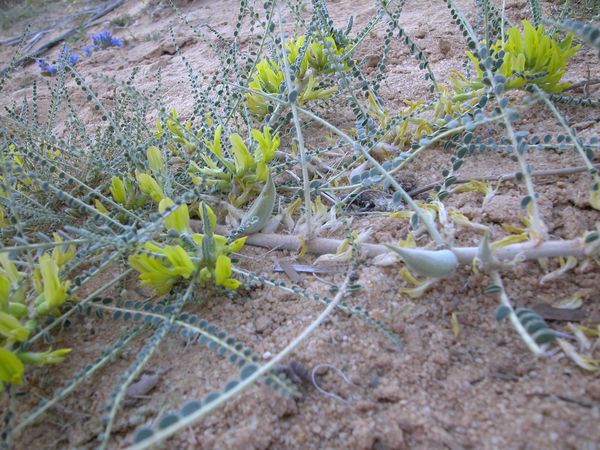Astragalus divaricatus: Red Data Book of Armenia

EN B 1 ab(i,ii,iii) + 2 ab(i,ii,iii)
Category. Endangered species. The extent of occurrence is less than 5000 km2, the area of occupancy is less than 500 km2. It was not included in the first edition of the Red Data Book of Armenia. It is not included in the Annexes of CITES and that of the Bern Convention.
Description. Small thorny cushion–shaped undershrub. Leaves 1,5–4 cm long; leaflets 4–7–paired, 2–6 x 1–2 mm. Inflorescence capitate, 2–2,5 cm in diameter, 3–4–flowered, sessile, axillary. Bracts shorter than calyx. Calyx 9–12 mm long, pubescent; teeth 6–8 mm long, setiform, ciliate. Corolla cream–coloured; flag longer than calyx. Style 5–8 mm long, equal to filaments.
Distribution. In Armenia it occurs in Zangezur (Khustup Mountain, between Sarnakunk and Spandaryan villages) and Darelegis (between Khachik, Gnishik and Mozrov villages) floristic regions. EOO is 800 km2, AOO is 12 km2, the number of locations is 4. Besides Armenia the species grows in North–West Iran.
Ecological, biological and phytocoenological peculiarities. Grows in sub–alpine belt, at the altitudes of 2200–2900 meters above sea level, in stony places, on limestone, in the meadows. Flowering in July, fruiting in August.
Limiting factors. Restricted extent of occurrence and area of occupancy, loss/degradation of habitats caused by land development, overgrazing.
Conservation actions. No conservation actions. Necessary: establishment of new specially protected nature area on Khustup
Suggestions
 The Ministry of Environment sent a letter international partners to draw their attention to the real danger of environmental disasters as a result of Azerbaijan's large-scale aggression towards the territory of Armenia
The Ministry of Environment sent a letter international partners to draw their attention to the real danger of environmental disasters as a result of Azerbaijan's large-scale aggression towards the territory of Armenia
 Vicia pisiformis: Red Data Book of Armenia
Vicia pisiformis: Red Data Book of Armenia
 Vavilovia formosa: Red Data Book of Armenia
Vavilovia formosa: Red Data Book of Armenia
 Trigonella capitata: Red Data Book of Armenia
Trigonella capitata: Red Data Book of Armenia
 Trigonella astroides: Red Data Book of Armenia
Trigonella astroides: Red Data Book of Armenia












